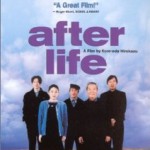WIT Life #261: After Life
WIT Life is a periodic series written by professional Writer/Interpreter/Translator Stacy Smith (Kumamoto-ken CIR, 2000-03). She starts her day by watching Fujisankei’s newscast in Japanese, and here she shares some of the interesting tidbits and trends along with her own observations.
Last night Japan Society concluded its Tribute to Donald Richie: Richie’s Fantastic Five with a screening of After Life (「ワンダフルライフ」), my favorite film from my favorite Japanese director, Hirokazu Kore-eda (The second part of the Richie Tribute, Richie’s Electric Eight, will start on March 13). It was released in 1998, and I remember catching it at the local arts cinema in my hometown. I hadn’t seen Kore-eda’s first film, Maboroshi (「幻の光」), and I was blown away by After Life. Maboroshi was based on a novel by Teru Miyamoto, but After Life is Kore-eda’s original screenplay, one he created after interviewing hundreds regarding recollections of their lives. In the film as well he actually used some of these non-actors to tell their stories.
The movie takes place at a way station where people are sent after they die. They are to reside there for a week, during which time they must pick one memory that they are allowed to take with them into the afterlife. Each counselor is assigned about seven people who they must help make this decision. The style of each employee varies, as does the nature of their clients. We meet elderly deceased who fondly recall their childhoods, as well as young deceased who struggle to find meaning in their short lives. The audience also later learns that the reason the staff works there is that they either couldn’t or wouldn’t pick a memory when they were in the same position after passing away.
The interviews with clients are shot in documentary style, a method familiar to Kore-eda as this genre is where his career was born. In the introduction to the film, a fun fact was shared regarding how After Life became the title of the film. The direct translation of the Japanese title would be Wonderful Life, but it was Donald Richie who told Kore-eda that Western viewers would associate that with It’s a Wonderful Life and urged him to change it. Richie was a big fan of Kore-eda’s since his debut with Maboroshi, and he promoted all of his films after that. Richie also had roots in the documentary world, so this was one of the things connecting them. Some say that it is Kore-eda’s beginning as a documentarian that enables him to have a sense of distance and a different perspective in his filmmaking.
Interestingly enough, Kore-eda’s next film was Distance (「ディスタンス), which told the story of members of a cult (based on Aum Shinrikyo) after they sabotage a city’s water supply (It also stars the young actor Arata, who is featured in After Life). In 1995, Aum Shinrikyo carried out a lethal sarin gas attack on the Tokyo subway which killed 13, severely injured 50 and caused temporary vision problems for almost 1000. This week my book club happens to be reading Underground, Haruki Murakami’s non-fiction work addressing this incident. In it he compiles stories from 60 survivors, all of whom were affected in some way by the attack. It really humanizes this indiscriminate act of violence and it is fascinating to hear how the morning’s events unfolded from those who were there, as well as learn how ill-equipped the handling by Japan’s emergency services was and see how much the media sensationalized the event.


Comments are closed.